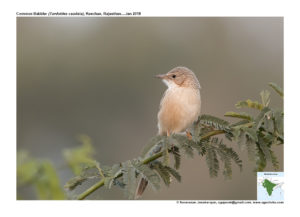
Common Babbler Turdoides caudate
Etymology:
- Turdoides: Latin word turdus- thrush; Greek word oides –resembling { Resembling Thrush}
- Caudata: Latin word for Tailed derived from cauda-tail
Vernacular Names : Persian: Susu, Duum daraaz, Baluchistan: Pinkulag, Sind: Heddo, Lailo, Hindi: Chilchil, Sor, Genga, Chhota genga, Dumri, Dumani, Sans: Gram-haholika, Pun: Serhari, Guj: Sheradi, Thoriyun lelum, Mar: Chota/ Samanya saatbhai, Ta: Huni, Te: Chinna sida, Mal: Chilappan, Kan: Havatamalla.
Distribution in India: Widespread Resident in India except in East and North East.
Description: Size of 20–26 cm; wt. of 30–40 g. It is a fairly small to medium-sized Turdoides babbler with rather slim decurved bill, fairly strong streaking above, mostly plain white and buff below with some streaking on breast side or on breast. The nominate race has dark buff crown and upperparts sometimes tinged cinnamon with brown-edged dark brown streaks, becoming more diffuse on rump; buffy-grey edges on mid-brown upperwing, and greyish-buff tail with dense but indistinct brown barring around shaft of central feathers. The lores and cheeks have pinkish-tan, ear-coverts have a pinkish-tan to darker greyish-brown. The chin, submoustachial area, throat, mid-breast and mid-belly whitish, neck side, breast side and flanks are pinkish-buff to rufous with diffuse dark shaft streaking. The iris is brown, orange-yellow or yellow; bill is flesh-brown or brown, yellow base of lower mandible; legs are yellowish. Both the sexes are similar. The juvenile has more rounded dark markings on head and nape, paler tips and outer webs of wing feathers. The race eclipes is slightly larger, longer-billed and paler than nominate, with slightly more streaking on breast side. The race huttoni is larger and longer-billed, paler and with greyish tinge above and on streaked breast side and flanks, streaks sometimes extending indistinctly across breast. The race salvadorii has streaking below that extends across breast and has narrow blackish shafts; throat and belly are buffier and greyer.
Habitat: It is found in semi-desert, dry plains, stony lower hills, thorn scrub-jungle, scrubland, sandy floodplains, grass and bushes, rocky ravines studded with bushes, dry cultivation, disturbed habitats, mixed forest, plantations, gardens, citrus groves and orchards. It is found from sea level up to 1200 m.
Food habits: It eats Ants, caterpillars, beetles, grasshoppers, termites, spiders. It also eats grain, berries and nectar of flowers. It also eats eggs of small birds. It forages in small groups usually of 6–7 individuals. It forages mainly on ground among leaf litter and roots, using the bill to flip over vegetation and to dig in soft earth. It will hawk termites in short sallies from bush top.
Breeding habits: They breed in Mar–Sept. They are multi-brooded. They are co-operative breeders, with three permutations: (i) group with single breeding pair, (ii) group with successively polygynous male, and (iii) group with two semi-simultaneously breeding pairs. The nest is built by both sexes. The nest is a neat, compact, rather thick-walled, deep cup, made of grasses, creeper stems, roots and twigs, lined with fine grasses, rootlets and horsehair, placed in thorny bush, small tree, and prickly-pear hedge, among fronds of low date palm or in tall grass or grass tussocks, above ground. They lay a clutch of 3–5 eggs. The incubation is done by both sexes. The incubation period is 13–15 days. The chicks are fed by both sexes. The nestling period is 12 days and post-fledging dependence protracted. The juveniles remain within group till the following breeding season. Brood parasitism is done by Jacobin Cuckoo and Common Hawk-cuckoo.